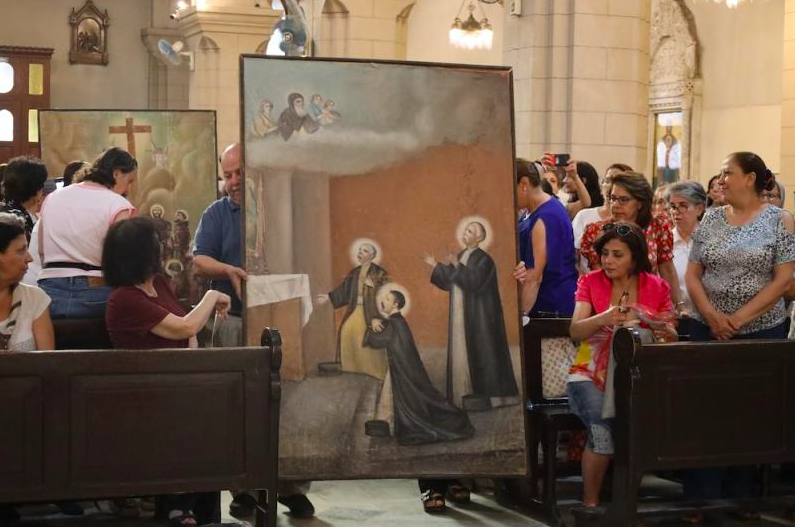The Massabki brothers new saints pray for peace in the Middle East
The martyrs of Damascus, three Maronite laymen killed in 1860 together with eight Franciscan friars in a wave of sectarian violence will be canonised tomorrow in Rome. The Syrian faithful will follow the ceremony in the church of Bab Touma where their martyrdom took place.
Beirut (AsiaNews) - Tomorrow the universal Church will be enriched by 14 new saintly figures, including eleven martyrs: eight Franciscan monks and three Maronite laymen, brothers Francis, Abdel Mohti and Raphaël Massabki, all brutally killed in Damascus on July 10, 1860, because of their Christian faith.
The context in which the so-called ‘Damascus massacres’ took place was complex. As a result of socio-economic changes,' writes historian Henri Laurens (1), ’Christian populations grew strongly during the 19th century (...). Moreover, thanks to the work of the missionaries, they had better access to modern education and thus a qualitative advantage in the labour market. Finally, under pressure from western public opinion, they had become an indicator of modernity: treating non-Muslim communities well was proof of a civilised political relationship with the population (...) Clashes between Druze and Christians became part of a confessional interpretation of the region. The massacres of 1860 were the result of the relative frustration of local Muslim groups with those who were believed to have benefited from the reforms, the recent changes in the balance of power and the intervention of external actors'.
The unprecedented explosion of sectarian violence, the result of frustrations built up since the first massacres in 1840, began in Mount Lebanon, before spreading to Zahlé and Damascus. The Massabki were one of the great families of Damascus. Francis, the eldest of three brothers, was the head of the family. Married with eight children, he was a silk merchant whose large house was open to all and whose popularity extended beyond Syria. It is said that bells rang in the villages as his caravan of mules approached.
When they heard the rioters approaching, the Massabki brothers took refuge in the nearby Franciscan friary, believing they were safe. But, led by a traitor, the invaders broke into the convent courtyard through a back door. Nothing prepared them for martyrdom but their profound courage and righteousness. The attackers captured Francis first.
The latter had lent 8,000 piastres to Abdallah el-Halabi, one of the instigators of the violence, along with the Ottoman governor Ahmed Pacha. On behalf of their master, they asked him to become a Muslim. He replied: ‘Sheikh Abdallah can keep my money. You can take my life. But no one can take my faith from me. I cannot deny my God (...). I am a Christian. He was slaughtered with daggers and axes. The fate of his brothers, Abdel Mohti, a family man and teacher with the Franciscans, and Raphaël, a rather simple man, was no better.
Nearly 20,000 Christians massacred
In total, almost 20,000 Christians were killed in 1860, 4 to 6,000 of them in Damascus between 9 and 18 July 1860. Eleven churches and three convents were destroyed in the Syrian capital, and between 1,500 and 2,000 houses and 200 shops were burnt and reduced to piles of stone.
News of the Damascus massacres reached Paris on 16 July 1860, which ordered an expedition of 7,000 soldiers to restore order. To appease France and the European powers, Fouad Pacha, the Ottoman Minister of Foreign Affairs, travelled to Syria. More than a hundred Ottoman officers and soldiers were shot for their role in the carnage. Governor Ahmed Pasha and 56 other officials were hanged.
The three Massabki brothers were beatified by the Catholic Church on 10 October 1926, together with the eight Franciscans (seven Spanish and one Austrian). The Maronite Church celebrates them on 10 July. On this day, the Greek Orthodox Church honours one of its priests, Youssef Mehanna Haddad, who was killed in Damascus under the same circumstances.
The Syrian faithful will be able to follow the canonisation ceremony tomorrow from the Franciscan church of Bab Touma, where the altar on which some of these martyrs had their throats slit is located. In a transparent shrine under the altar, a number of skulls and bones are visible, symbolically representing the relics of the martyrs of Damascus. According to tradition, all the victims of the convent were buried together. The Maronite Synod asked the faithful to elevate their prayers so that, through their intercession, peace may be restored in the Middle East.
1. Henry Laurens, Histoire contemporaine du monde arabe







.png)










